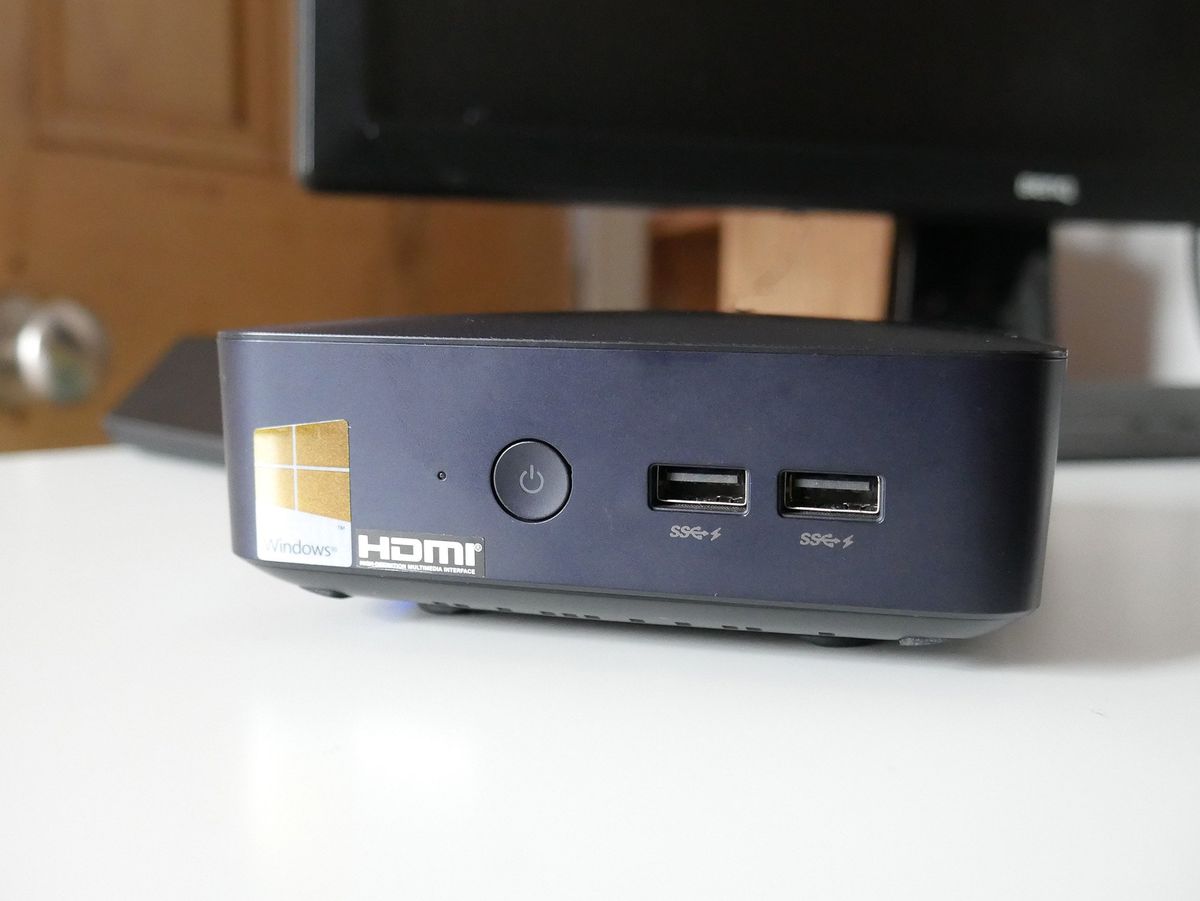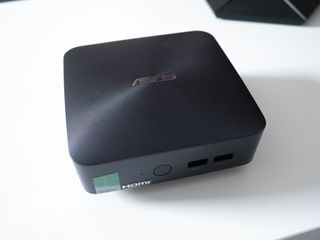
The growth of the small-form-factor PC continues, and where once you'd probably have to go for a barebones kit or a pretty low-powered option, this is no longer true. Thanks to advancements in the PC hardware industry, it's now possible to squeeze an awful lot of performance into a tiny box.
Enter the latest ASUS VivoMini. Beneath its diminutive exterior lies hardware that can give some much more expensive laptops a run for their money. This is one of the beauties of the mini PC. If you don't need, want or have space for a large desktop machine, you have plenty of choices and you don't have to make many compromises.
ASUS VivoMini tech specs (as tested)
| Category | Spec |
|---|---|
| OS | Windows 10 Pro 64-bit |
| Processor | Seventh Gen (Kaby Lake)Intel Core i5 7200U |
| Internal storage | 128GB solid state drive (SSD) |
| RAM | 8GB DDR4 |
| Graphics | Intel HD 620 |
| Ports | four USB 3.0 ports, SD card, Gigabit Ethernet, HDMI, DisplayPort, combined 3.5mm headset and microphone |
| Wireless | 802.11ac and Bluetooth 4.0 |
| Dimensions | 131 mm x 131 mm x 42 mm |
| Weight | 0.6 kg |
| Price | $349 |
ASUS VivoMini: Inside and out
Unlike some of the larger gaming rigs out there that come in bizarre cases that scream to be looked at, the VivoMini is basically just a box you're probably going to tuck out of sight. That's not a sleight on its appearance, but it's also not really a big deal.
On top you have ASUS's trademark concentric circle pattern, broken only by the company logo. Otherwise, it's just a very dark blue box with rounded edges. It looks smart, at least, so if you're going to have it on show somewhere it won't look out of place. There's not a lot more you can say about it.
It may be small but it's packed with ports.
Most of the stuff you'll be using to connect various items to the VivoMini is hidden around the back, including ports for USB, HDMI and SD cards. There's a front-facing USB, most useful for plugging in a keyboard, and the power button is also on the front side rather than hidden away.
The power button shuts the PC down properly rather than just turning it off, which is a nice touch. Given that a PC like this would be great for a home theater setup, being able to just prod the button and get a proper shutdown is convenient.
What's inside of our review model is the sort of hardware you'd expect to see in a decent laptop. The lineup has been refreshed to add the latest seventh-generation "Kaby Lake" processors from Intel, and this one is running a dual-core i5. For something this small, that's very good, especially because in the past you may have expected an Atom processor in some of these types of PCs.
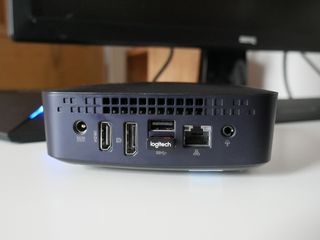
That's backed up by 8GB of DDR4 RAM and 128GB of SSD storage. ASUS uses an m.2 size drive, but it's probably not the best thing to upgrade because there's no immediately obvious way to get inside it.
The included VESA bracket is a great touch.
Inside the box, you get a VESA mounting kit, which means you can easily attach the VivoMini to the back of a PC monitor or a TV, making yourself a makeshift all-in-one. This kind of PC is ideal to do just that with, and it's great to see ASUS thinking out of the box. The bracket attaches to the bottom of the PC by a couple of screws, and then there are the standard four screws to fix the whole thing to the mounting points on your display.
As it's just a flat bracket, it doesn't impede access to any of the ports or the power button. It's a nice touch, and we give extra points to ASUS for throwing it in.
There is but one mild critique of the overall hardware package: there isn't an optical drive. On this type of PC where there could be some serious home theater (HTPC) thought, there will be plenty of folks who would have preferred to have a Blu-ray drive included.
The software is ... bloaty
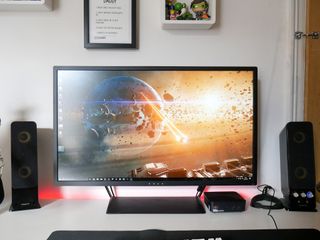
The VivoMini sadly suffers from the standard ASUS PC problem of being loaded up with far more crapware than anyone should ever have to look at. Getting a popup for McAfee isn't a good experience on any PC, especially one you've literally just set up.
Yes, it's worth money to ASUS but I still feel like it sells out some of the user experience. That's sad, because the hardware is top notch.
Otherwise, you're looking at Windows 10 Home 64-bit, and our review unit updated to the Creators Update at setup. It also came loaded with the Windows 10 upgrade assistant, which if carried over to the retail units is a handy thing to include.
ASUS VivoMini performance
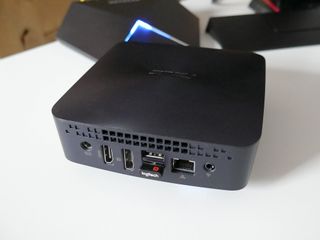
A gaming PC this is not, nor will it ever be, because there's no chance of using it with an external GPU; it doesn't have Thunderbolt 3. It does have Windows 10, 5GHz Wi-Fi and Ethernet, so it could be a companion device for streaming your Steam library, or even your Xbox One games.
This is a desktop PC for normal desktop PC things, so the bar for performance is somewhat lower. That said, the VivoMini doesn't disappoint, especially considering that it's really quite affordable.
Let's look at some benchmark and performance numbers.
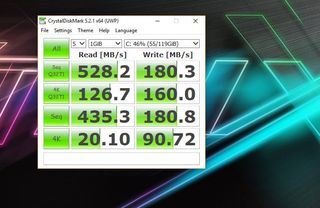
The SSD performance isn't anything outstanding, but it's substantially better than you would get from an HDD. In reality, it boots quickly and for the sort of computing you're doing on a unit like this, more than ample.


For a Core i5 processor the Geekbench numbers call where you'd expect, and if you compare in the table below to some of the best ultrabooks out there, you'll see you're getting quite a lot out of this $349 box.
Geekbench 4.0 Benchmarks (Higher is better)
| Category | Score |
|---|---|
| ASUS VivoMini | Single core: 3,460 | Dual core: 6,200 |
| Surface Book Core i7 | Single core: 3,948 | Dual core: 7,415 |
| Spectre x360 Core i7 | Single core: 4,100 | Dual core: 7,469 |
| XPS 13 Kaby Core i7 | Single core: 4,120| Dual core: 7,829 |
It's also worth commenting on how quiet the VivoMini is, even during stress. It's impossible to put a large fan inside, but even so, you're not going to sit there pulling your hair out because it's driving you mad with noise. There's an audible fan noise, but it's nothing heavy.
It also stays fairly cool on the top and front, with the excess heat ventilated out of the back of the PC. If you're mounting it to the back of a display, presumably the vents will face down, but be aware that there's a fairly strong amount of heat kicked out.
ASUS VivoMini review: Bottom line
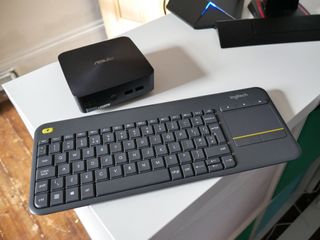
This type of PC won't appeal to everyone, but it's more appealing than you may have thought. This little box is a huge step up from some of the super-cheap, low-power PCs you might find browsing the pages of Amazon.
This is a perfect option for a HTPC in the living room.
What the VivoMini is, is a proper PC in a little box. There's no corner cutting. You get a good processor, plenty of RAM and storage, and a PC that performs well, is fairly efficient, and takes up very little room.
It's a perfect option for those tight on space, particularly those looking for a HTPC in the living room. OK, there's no optical drive, but the included VESA mount helps take away the sting there.
It's pretty easy to recommend. If you want a smart desktop PC that takes up almost no room, doesn't cost the earth at $349 and performs well, buy one of these. And then quickly remove the bloatware, of course.

Richard Devine is a Managing Editor at Windows Central with over a decade of experience. A former Project Manager and long-term tech addict, he joined Mobile Nations in 2011 and has been found on Android Central and iMore as well as Windows Central. Currently, you'll find him steering the site's coverage of all manner of PC hardware and reviews. Find him on Mastodon at mstdn.social/@richdevine
